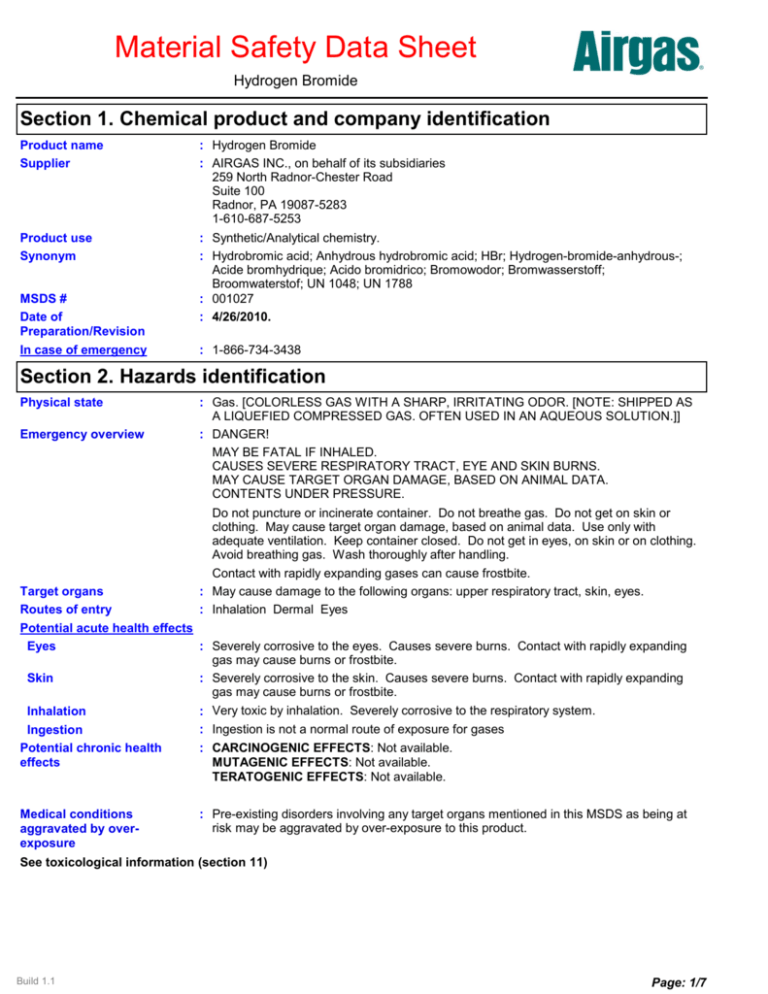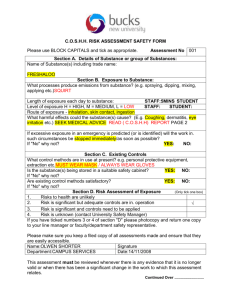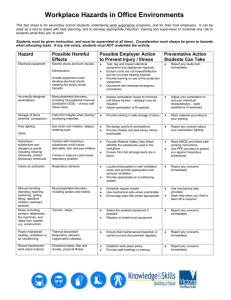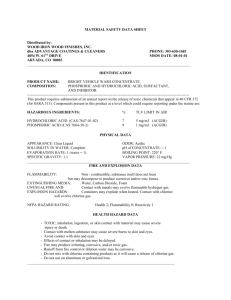Hydrobromic acid
advertisement

Material Safety Data Sheet Hydrogen Bromide Section 1. Chemical product and company identification Product name Supplier : Hydrogen Bromide : AIRGAS INC., on behalf of its subsidiaries 259 North Radnor-Chester Road Suite 100 Radnor, PA 19087-5283 1-610-687-5253 Product use Synonym : Synthetic/Analytical chemistry. : Hydrobromic acid; Anhydrous hydrobromic acid; HBr; Hydrogen-bromide-anhydrous-; Acide bromhydrique; Acido bromidrico; Bromowodor; Bromwasserstoff; Broomwaterstof; UN 1048; UN 1788 : 001027 : 4/26/2010. MSDS # Date of Preparation/Revision In case of emergency : 1-866-734-3438 Section 2. Hazards identification Physical state Emergency overview : Gas. [COLORLESS GAS WITH A SHARP, IRRITATING ODOR. [NOTE: SHIPPED AS A LIQUEFIED COMPRESSED GAS. OFTEN USED IN AN AQUEOUS SOLUTION.]] : DANGER! MAY BE FATAL IF INHALED. CAUSES SEVERE RESPIRATORY TRACT, EYE AND SKIN BURNS. MAY CAUSE TARGET ORGAN DAMAGE, BASED ON ANIMAL DATA. CONTENTS UNDER PRESSURE. Do not puncture or incinerate container. Do not breathe gas. Do not get on skin or clothing. May cause target organ damage, based on animal data. Use only with adequate ventilation. Keep container closed. Do not get in eyes, on skin or on clothing. Avoid breathing gas. Wash thoroughly after handling. Contact with rapidly expanding gases can cause frostbite. Target organs : May cause damage to the following organs: upper respiratory tract, skin, eyes. Routes of entry : Inhalation Dermal Eyes Potential acute health effects Eyes : Severely corrosive to the eyes. Causes severe burns. Contact with rapidly expanding gas may cause burns or frostbite. Skin : Severely corrosive to the skin. Causes severe burns. Contact with rapidly expanding gas may cause burns or frostbite. Inhalation : Very toxic by inhalation. Severely corrosive to the respiratory system. Ingestion Potential chronic health effects : Ingestion is not a normal route of exposure for gases Medical conditions aggravated by overexposure : Pre-existing disorders involving any target organs mentioned in this MSDS as being at risk may be aggravated by over-exposure to this product. : CARCINOGENIC EFFECTS: Not available. MUTAGENIC EFFECTS: Not available. TERATOGENIC EFFECTS: Not available. See toxicological information (section 11) Build 1.1 Page: 1/7 Hydrogen Bromide Section 3. Composition, Information on Ingredients Name Hydrogen Bromide CAS number 10035-10-6 % Volume 100 Exposure limits ACGIH TLV (United States, 1/2009). C: 2 ppm NIOSH REL (United States, 6/2009). CEIL: 10 mg/m³ CEIL: 3 ppm OSHA PEL (United States, 11/2006). TWA: 10 mg/m³ 8 hour(s). TWA: 3 ppm 8 hour(s). OSHA PEL 1989 (United States, 3/1989). CEIL: 10 mg/m³ CEIL: 3 ppm Section 4. First aid measures No action shall be taken involving any personal risk or without suitable training.If it is suspected that fumes are still present, the rescuer should wear an appropriate mask or self-contained breathing apparatus.It may be dangerous to the person providing aid to give mouth-to-mouth resuscitation. Eye contact : Check for and remove any contact lenses. Immediately flush eyes with plenty of water for at least 15 minutes, occasionally lifting the upper and lower eyelids. Get medical attention immediately. Skin contact : In case of contact, immediately flush skin with plenty of water for at least 15 minutes while removing contaminated clothing and shoes. Wash clothing before reuse. Clean shoes thoroughly before reuse. Get medical attention immediately. Frostbite : Try to warm up the frozen tissues and seek medical attention. Inhalation : Call medical doctor or poison control center immediately. Move exposed person to fresh air. If not breathing, if breathing is irregular or if respiratory arrest occurs, provide artificial respiration or oxygen by trained personnel. Loosen tight clothing such as a collar, tie, belt or waistband. Get medical attention immediately. Ingestion : As this product is a gas, refer to the inhalation section. Section 5. Fire-fighting measures Flammability of the product Products of combustion Fire-fighting media and instructions Special protective equipment for fire-fighters : Non-flammable. : Decomposition products may include the following materials: halogenated compounds : Use an extinguishing agent suitable for the surrounding fire. Apply water from a safe distance to cool container and protect surrounding area. If involved in fire, shut off flow immediately if it can be done without risk. Contains gas under pressure. In a fire or if heated, a pressure increase will occur and the container may burst or explode. : Fire-fighters should wear appropriate protective equipment and self-contained breathing apparatus (SCBA) with a full face-piece operated in positive pressure mode. Section 6. Accidental release measures Personal precautions Environmental precautions Methods for cleaning up Build 1.1 : Immediately contact emergency personnel. Keep unnecessary personnel away. Use suitable protective equipment (section 8). Shut off gas supply if this can be done safely. Isolate area until gas has dispersed. : Avoid dispersal of spilled material and runoff and contact with soil, waterways, drains and sewers. : Immediately contact emergency personnel. Stop leak if without risk. Note: see section 1 for emergency contact information and section 13 for waste disposal. Page: 2/7 Hydrogen Bromide Section 7. Handling and storage Handling : Use only with adequate ventilation. Wash thoroughly after handling. High pressure gas. Do not puncture or incinerate container. Use equipment rated for cylinder pressure. Close valve after each use and when empty. Do not get in eyes, on skin or on clothing. Keep container closed. Do not get on skin or clothing. Protect cylinders from physical damage; do not drag, roll, slide, or drop. Use a suitable hand truck for cylinder movement. Storage : Cylinders should be stored upright, with valve protection cap in place, and firmly secured to prevent falling or being knocked over. Cylinder temperatures should not exceed 52 °C (125 °F). Section 8. Exposure controls/personal protection Engineering controls Personal protection Eyes Skin Respiratory Hands Personal protection in case of a large spill : Use only with adequate ventilation. Use process enclosures, local exhaust ventilation or other engineering controls to keep worker exposure to airborne contaminants below any recommended or statutory limits. : Safety eyewear complying with an approved standard should be used when a risk assessment indicates this is necessary to avoid exposure to liquid splashes, mists or dusts. : Personal protective equipment for the body should be selected based on the task being performed and the risks involved and should be approved by a specialist before handling this product. : Use a properly fitted, air-purifying or air-fed respirator complying with an approved standard if a risk assessment indicates this is necessary. Respirator selection must be based on known or anticipated exposure levels, the hazards of the product and the safe working limits of the selected respirator. The applicable standards are (US) 29 CFR 1910.134 and (Canada) Z94.4-93 : Chemical-resistant, impervious gloves complying with an approved standard should be worn at all times when handling chemical products if a risk assessment indicates this is necessary. : Self-contained breathing apparatus (SCBA) should be used to avoid inhalation of the product. Full chemical-resistant suit and self-contained breathing apparatus should be worn only by trained and authorized persons. Product name Hydrobromic acid ACGIH TLV (United States, 1/2009). C: 2 ppm NIOSH REL (United States, 6/2009). CEIL: 10 mg/m³ CEIL: 3 ppm OSHA PEL (United States, 11/2006). TWA: 10 mg/m³ 8 hour(s). TWA: 3 ppm 8 hour(s). OSHA PEL 1989 (United States, 3/1989). CEIL: 10 mg/m³ CEIL: 3 ppm Consult local authorities for acceptable exposure limits. Section 9. Physical and chemical properties Molecular weight Molecular formula Boiling/condensation point Melting/freezing point Critical temperature Vapor pressure Vapor density Specific Volume (ft 3/lb) Build 1.1 : : : : : : : : 80.92 g/mole Br-H -66.7°C (-88.1°F) -86.7°C (-124.1°F) Not available. 320 (psig) 2.81 (Air = 1) 4.8008 Page: 3/7 Hydrogen Bromide Gas Density (lb/ft 3) : 0.2083 Section 10. Stability and reactivity Stability and reactivity Hazardous decomposition products Hazardous polymerization : The product is stable. : Under normal conditions of storage and use, hazardous decomposition products should not be produced. : Under normal conditions of storage and use, hazardous polymerization will not occur. Section 11. Toxicological information Toxicity data Product/ingredient name Hydrobromic acid IDLH Chronic effects on humans Other toxic effects on humans Specific effects Carcinogenic effects Mutagenic effects Reproduction toxicity Result LD50 Intraperitoneal LC50 Inhalation Gas. LC50 Inhalation Gas. LC50 Inhalation Gas. LC50 Inhalation Gas. Species Rat Rat Dose 76 mg/kg 3000 ppm Exposure 30 minutes Rat 2858 ppm 1 hours Rat 2858 ppm 1 hours Mouse 814 ppm 1 hours : 30 ppm : May cause damage to the following organs: upper respiratory tract, skin, eyes. : Extremely hazardous by the following route of exposure: of skin contact (corrosive), of eye contact (corrosive), of inhalation (lung corrosive). Hazardous by the following route of exposure: of inhalation (lung irritant). : No known significant effects or critical hazards. : No known significant effects or critical hazards. : No known significant effects or critical hazards. Section 12. Ecological information Aquatic ecotoxicity Not available. Environmental fate Environmental hazards Toxicity to the environment : Not available. : No known significant effects or critical hazards. : Not available. Section 13. Disposal considerations Product removed from the cylinder must be disposed of in accordance with appropriate Federal, State, local regulation.Return cylinders with residual product to Airgas, Inc.Do not dispose of locally. Section 14. Transport information Regulatory information UN number Proper shipping name Class Packing group DOT Classification UN1048 HYDROGEN BROMIDE, ANHYDROUS 2.3 Not applicable (gas). Label Additional information Limited quantity Yes. Packaging instruction Passenger aircraft Quantity limitation: Build 1.1 Page: 4/7 Hydrogen Bromide Forbidden. Cargo aircraft Quantity limitation: Forbidden. Special provisions 3, B14 TDG Classification UN1048 HYDROGEN BROMIDE, ANHYDROUS 2.3 Not applicable (gas). Explosive Limit and Limited Quantity Index 0 ERAP Index 25 Passenger Carrying Ship Index Forbidden Passenger Carrying Road or Rail Index Forbidden Mexico Classification UN1048 HYDROGEN BROMIDE, ANHYDROUS 2.3 Not applicable (gas). - “Refer to CFR 49 (or authority having jurisdiction) to determine the information required for shipment of the product.” Section 15. Regulatory information United States U.S. Federal regulations : United States inventory (TSCA 8b): This material is listed or exempted. SARA 302/304/311/312 extremely hazardous substances: No products were found. SARA 302/304 emergency planning and notification: No products were found. SARA 302/304/311/312 hazardous chemicals: Hydrobromic acid SARA 311/312 MSDS distribution - chemical inventory - hazard identification: Hydrobromic acid: Sudden release of pressure, Immediate (acute) health hazard Clean Water Act (CWA) 307: No products were found. Clean Water Act (CWA) 311: No products were found. Clean Air Act (CAA) 112 accidental release prevention: No products were found. Clean Air Act (CAA) 112 regulated flammable substances: No products were found. Clean Air Act (CAA) 112 regulated toxic substances: No products were found. Build 1.1 Page: 5/7 Hydrogen Bromide State regulations Canada WHMIS (Canada) : Connecticut Carcinogen Reporting: This material is not listed. Connecticut Hazardous Material Survey: This material is not listed. Florida substances: This material is not listed. Illinois Chemical Safety Act: This material is not listed. Illinois Toxic Substances Disclosure to Employee Act: This material is not listed. Louisiana Reporting: This material is not listed. Louisiana Spill: This material is not listed. Massachusetts Spill: This material is not listed. Massachusetts Substances: This material is listed. Michigan Critical Material: This material is not listed. Minnesota Hazardous Substances: This material is not listed. New Jersey Hazardous Substances: This material is listed. New Jersey Spill: This material is not listed. New Jersey Toxic Catastrophe Prevention Act: This material is listed. New York Acutely Hazardous Substances: This material is not listed. New York Toxic Chemical Release Reporting: This material is not listed. Pennsylvania RTK Hazardous Substances: This material is listed. Rhode Island Hazardous Substances: This material is not listed. : Class A: Compressed gas. Class D-1A: Material causing immediate and serious toxic effects (Very toxic). Class E: Corrosive material CEPA Toxic substances: This material is not listed. Canadian ARET: This material is not listed. Canadian NPRI: This material is not listed. Alberta Designated Substances: This material is not listed. Ontario Designated Substances: This material is not listed. Quebec Designated Substances: This material is not listed. Section 16. Other information United States Label requirements Canada Label requirements Hazardous Material Information System (U.S.A.) National Fire Protection Association (U.S.A.) : MAY BE FATAL IF INHALED. CAUSES SEVERE RESPIRATORY TRACT, EYE AND SKIN BURNS. MAY CAUSE TARGET ORGAN DAMAGE, BASED ON ANIMAL DATA. CONTENTS UNDER PRESSURE. : Class A: Compressed gas. Class D-1A: Material causing immediate and serious toxic effects (Very toxic). Class E: Corrosive material : Health * 3 Flammability 0 Physical hazards 0 : Flammability 0 Health 3 0 Instability Special Notice to reader Build 1.1 Page: 6/7 Hydrogen Bromide To the best of our knowledge, the information contained herein is accurate. However, neither the above-named supplier, nor any of its subsidiaries, assumes any liability whatsoever for the accuracy or completeness of the information contained herein. Final determination of suitability of any material is the sole responsibility of the user. All materials may present unknown hazards and should be used with caution. Although certain hazards are described herein, we cannot guarantee that these are the only hazards that exist. Build 1.1 Page: 7/7







